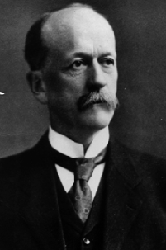The Discovery of the Burgess Shale
 The Burgess Shale beds were first discovered
in August, 1909, by Charles Doolittle Walcott of
the Smithsonian Institution, Washington, D.C., U.S.A. Legend has it that this remarkable discovery was an accident. Walcott and his
field party had been travelling by horse near Mount Wapta
when they stopped to remove rocks blocking the path. Much to their surpise they found that these slabs contained fossilized
carbon films of soft tissues. One of the first
fossils that Walcott described was an arthropod named Marella splendens.
The Burgess Shale beds were first discovered
in August, 1909, by Charles Doolittle Walcott of
the Smithsonian Institution, Washington, D.C., U.S.A. Legend has it that this remarkable discovery was an accident. Walcott and his
field party had been travelling by horse near Mount Wapta
when they stopped to remove rocks blocking the path. Much to their surpise they found that these slabs contained fossilized
carbon films of soft tissues. One of the first
fossils that Walcott described was an arthropod named Marella splendens.
Walcott subsequently opened two quarries between Mount Wapta and Mount Field. The Phyllopod bed from which Walcott obtained many of his specimens was located in the Lower (Walcott's) Quarry. The second quarry, Raymond's Quarry, was located 20 m above Walcott's Quarry. This quarry was named for P.E. Raymond, a prominent fossil collector.
Walcott published many papers on the Burgess Shale faunas during the next three decades, although many of his interpretations were subsequently revised.
Click here to view the preservation of the Burgess Shale
Return to table of contents
 The Burgess Shale beds were first discovered
in August, 1909, by Charles Doolittle Walcott of
the Smithsonian Institution, Washington, D.C., U.S.A. Legend has it that this remarkable discovery was an accident. Walcott and his
field party had been travelling by horse near Mount Wapta
when they stopped to remove rocks blocking the path. Much to their surpise they found that these slabs contained fossilized
carbon films of soft tissues. One of the first
fossils that Walcott described was an arthropod named Marella splendens.
The Burgess Shale beds were first discovered
in August, 1909, by Charles Doolittle Walcott of
the Smithsonian Institution, Washington, D.C., U.S.A. Legend has it that this remarkable discovery was an accident. Walcott and his
field party had been travelling by horse near Mount Wapta
when they stopped to remove rocks blocking the path. Much to their surpise they found that these slabs contained fossilized
carbon films of soft tissues. One of the first
fossils that Walcott described was an arthropod named Marella splendens.